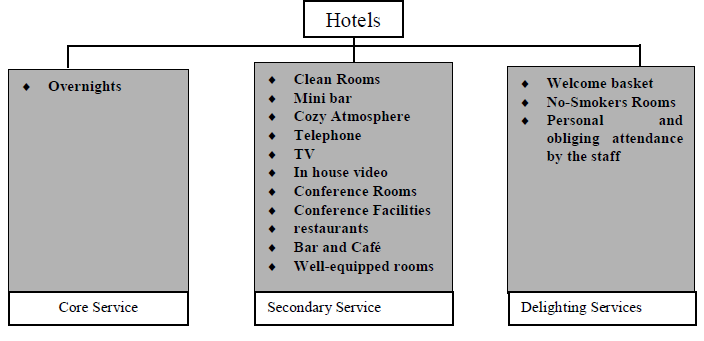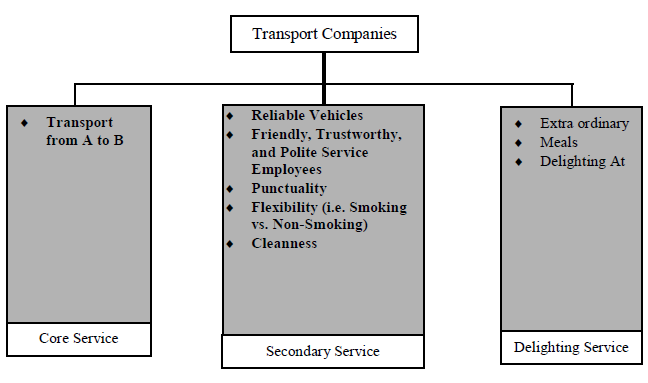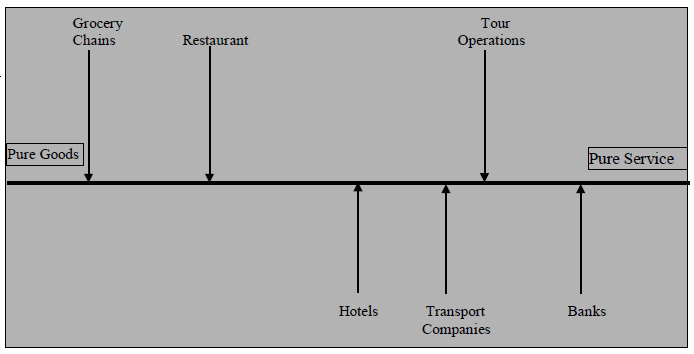EXECUTIVE SUMMARY
The purpose of this thesis is to examine selected elements, which have influence on customer satisfaction in services. The investigation is conducted bot from a theoretical and empirical point of view. The theoretical analysis considers four dimensions. The first dimension is concerned with the service company’s internal services, which have an indirect influence on the overall customer satisfaction.
It focuses on internal services which involves an analysis of operations, processes, and activities which influence the behavior of employees within service companies, e.g. internal marketing decision making processes, management styles, communication patterns, empowerment, and employee motivation.
The second dimension deals with the external value and therewith the relation between service providers and their customers. It focuses on issues of strategic service marketing relating to customer satisfaction, e.g. service marketing mix, service delivery, and service encounter. The third dimension takes the concept of service quality into account which corresponds to the level of customer satisfaction. Service quality is determined by the following criteria.
- Analogy between the customer’s expectation and his actual perception of the service performance.
- The service company’s knowledge of their customer’s needs and expectations.
- Creation and implementation of service quality standards in line with customer’s expectations.
- The match between intended and actual service delivery.
- Analogy between the service company’s image and the actual service performance.
The concept of service quality is then evaluated on several dimensions, which are the tangibles, reliability, responsiveness, assurance, and empathy of service companies. The fourth dimension of the theoretical part deals with the main consequences when obtaining satisfied customers- customer loyalty and long time profitability.
The theoretical findings are further supplemented by an empirical analysis emphasizing internal service operation, the service product and development, service quality, service recovery, and customer loyalty within different service branches. The empirical research reveals that service companies in different service branches demonstrate significant differences concerning the elements in question.
THEORETICAL FOUNDATION
Ford and Fottler (1995) propose the employee empowerment grid which demonstrates the different related stages concerning decision-making authority over fob content and context. According to Ford and Fottler (1995), all jobs have two dimensions: Content and context. The job content includes tasks and prescription necessary to execute a job. Job context refers to both the organizational overall mission and vision, as well as the organizational setting and structure, and how the particular job is carried out.
Figure 4.2 indicates that internal processes are invisible to the customer. It is possible to divide the service delivery processes into subprocesses in order to identify potential strength and weaknesses. Schneider and Bower (1995) stress that the breaking down of service processes as shown shown above produces a picture of the components of service delivery system which can help to weave together the competing logic of different organizational functions.
She points out that service companies, during the service encounter. She points out that service companies should manage and control every single service encounter because this is the period of time which has most influence on the customer’s evaluation of the provided service product. Figure 4.8 shows the relationship between service encounter and service quality.
To further expand the usefulness of their model, they have calculated the impact of a five per cent increase in retention rate for various service branches. While the power of retention depends upon the shape of the curve in Figure 6.3 and the point on the curve at which a company finds itself, the percentage increases in profit ranged from 25 per cent experienced in the insurance industry, to 125 per cent in the credit card industry (Heskett, Sasser and Hart, 190).
EMPIRICAL ANALYSIS

Figure 7.1: Core, Secondary and Delighting Service in Hotels.
The Final distinctive characteristic relates to the three levels of services: Core, Secondary, and Delighting attributes. Figure 7.1 illustrates one possible suggestion of core secondary, and delighting services in the hotel branch.

Figure 7.3: Core, Secondary and Delighting Service in Transport Companies.
Also the third business in the transport branch, the car rental firms, provide a vehicle as their technical equipment. Their business is less people based, because the renter is using the car himself, getting personal treatment only when picking up or delivering the car. The secondary services car rental firms provide to their customers are the availability of cars, payments facilities, accessibility, flexibility when delivering the car, cleanness, etc. The following Figure 7.3 illustrates one possible suggestion of core, secondary, and delighting services in the transport business.

Figure 7.7: Service-Goods Continuum for Various Service Branches.
Figure 7.7 it can be seen that grocery chains and banks each are placed in the extreme ends of the continuum. They provide to customers physical goods and expertise, respectively, which determines their position. As tour operators organize holidays for customers, their product is rather service oriented and less goods oriented. The same is true for transport companies, but their service is more influenced by their physical equipment.
CONCLUSION
The purpose of this chapter is to outline the elements, which influence, restrict, and enhance customer satisfaction. The elements identified in the theoretical foundation will be reviewed and compared to the findings of the empirical research. First the issues relating to the internal operations will be outlined. These issues contribute to the external performance of service companies. Secondly, the external value for service customers and their satisfaction will be reviewed from a strategic point of view. Finally, the relation to customer loyalty and profitability will be illuminated.
I have identified internal services as the crucial element which influences the external performance of service companies. By internal services we interpret the various operations, professes, and activities which influence the behavior of service employees. The relevance of optimizing the internal services is founded in the service marketing and management proposition. This proposition argues that external success is rooted in a well functioning organization. It has been shown that the following issues are or importance for the optimization of internal services: Internal marketing, management and decision making styles, motivation and rewards systems. The main ideas behind each issue will be revised both from the theoretical and the empirical perspective.
The concept of internal marketing prescribes that the employees regard their colleagues as internal customers. This implies that every employee strives to satisfy their co-workers. One prerequisite is that the management facilities internal customers. This implies that every employee strives to satisfy their co-workers. One prerequisite is that the management facilities internal marketing by expressing their strong interest in their subordinates. The purpose is to create a working environment, which supports the close cooperation between all members of an organization. It has been argued that a favorable working environment has positive effect on employee’s job satisfaction. Consequently, their satisfaction stimulates employees to perform well in their service task.
Source: Blekinge Institute of Technology
Authors: Mohammad Rafiqul Islam | Anders Hederstierna



